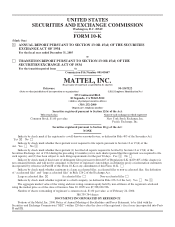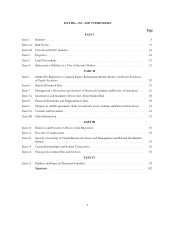Mattel 2005 Annual Report Download - page 15
Download and view the complete annual report
Please find page 15 of the 2005 Mattel annual report below. You can navigate through the pages in the report by either clicking on the pages listed below, or by using the keyword search tool below to find specific information within the annual report.Competition and Industry Background
Mattel has historically competed primarily against companies in the toy industry. Mattel also competes
increasingly with companies in other industries who make products that satisfy children’s entertainment
demands, including but not limited to makers of video games and consumer electronic products.
Competition in the toy industry is intense and is based primarily on quality, play value and price. The Mattel
Girls & Boys Brands US and Fisher-Price Brands US segments compete with several large toy companies,
including Hasbro, Inc., Jakks Pacific, Lego, Leap Frog, Bandai, MGA Entertainment and many smaller toy
companies. American Girl Brands competes with toy companies in the doll category, and to a lesser extent, with
children’s book publishers and retailers in the girls category. Mattel’s International segment competes with
global toy companies including Hasbro, Lego, Tomy, Bandai, MGA Entertainment and other national and
regional toy companies. Foreign national and regional toy markets may include competitors who are strong in a
particular toy line or geographical area, but do not compete with Mattel and other international toy companies
worldwide. Additionally, several large retailers have offered competing products under their own private labels.
Due to recent trends towards shorter life cycles for individual toy products, the phenomenon of children
outgrowing toys at younger ages and an increasing use of high technology in toys, Mattel must also compete with
many other companies, including the makers of video games and consumer electronic products, to meet the
entertainment demands of older children.
Seasonality
Mattel’s business is highly seasonal, with consumers making a large percentage of all toy purchases during
the traditional holiday season. A significant portion of Mattel’s customers’ purchasing occurs in the third and
fourth quarters of Mattel’s fiscal year in anticipation of such holiday buying. These seasonal purchasing patterns
and requisite production lead times cause risk to Mattel’s business associated with the underproduction of
popular toys and the overproduction of toys that do not match consumer demand. Retailers are also attempting to
manage their inventories more tightly in recent years, requiring Mattel to ship products closer to the time the
retailers expect to sell the products to consumers. These factors increase the risk that Mattel may not be able to
meet demand for certain products at peak demand times, or that Mattel’s own inventory levels may be adversely
impacted by the need to pre-build products before orders are placed. Additionally, as retailers manage their
inventories, Mattel experiences cyclical ordering patterns for products and product lines that may cause its sales
to vary significantly from period to period.
In anticipation of retail sales in the traditional holiday season, Mattel significantly increases its production
in advance of the peak selling period, resulting in a corresponding build-up of inventory levels in the first three
quarters of its fiscal year. Seasonal shipping patterns result in significant peaks in the third and fourth quarters in
the respective levels of inventories and accounts receivable, which result in seasonal working capital financing
requirements. See “Seasonal Financing.”
Product Design and Development
Through its product design and development group, Mattel regularly refreshes, redesigns and extends
existing toy product lines and develops innovative new toy product lines for all segments. Mattel believes its
success is dependent on its ability to continue this activity effectively. See Item 1A “Risk Factors—Factors That
May Affect Future Results.” Product design and development are principally conducted by a group of
professional designers and engineers employed by Mattel. During 2005, 2004 and 2003, Mattel spent
$182.0 million, $171.3 million and $167.4 million, respectively, in connection with the design and development
of products, exclusive of royalty payments. See Item 8 “Financial Statements and Supplementary Data—Note 13
to the Consolidated Financial Statements.”
6
























